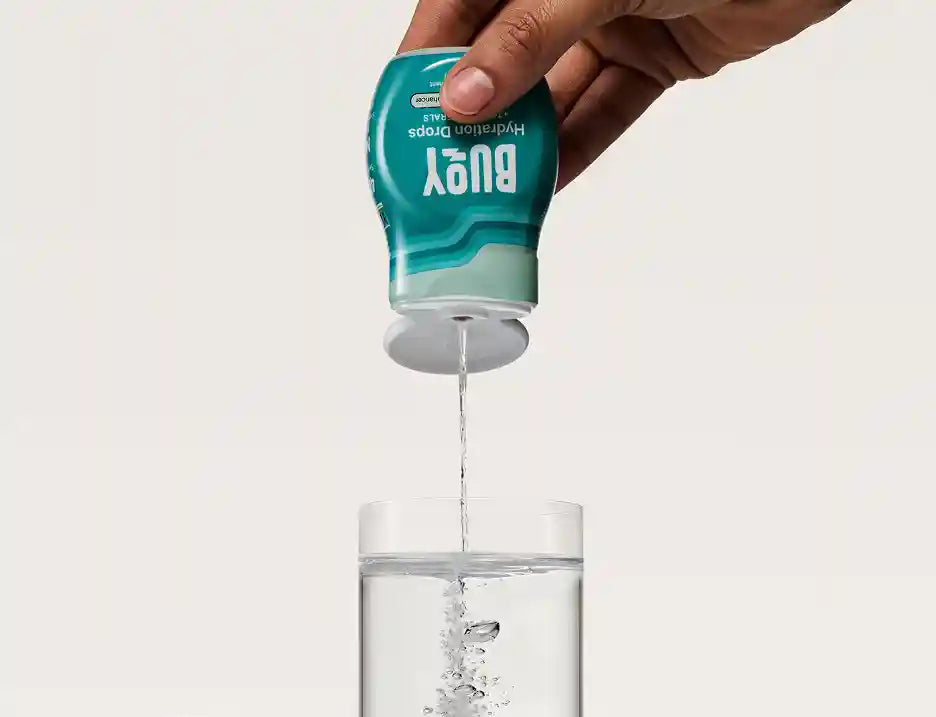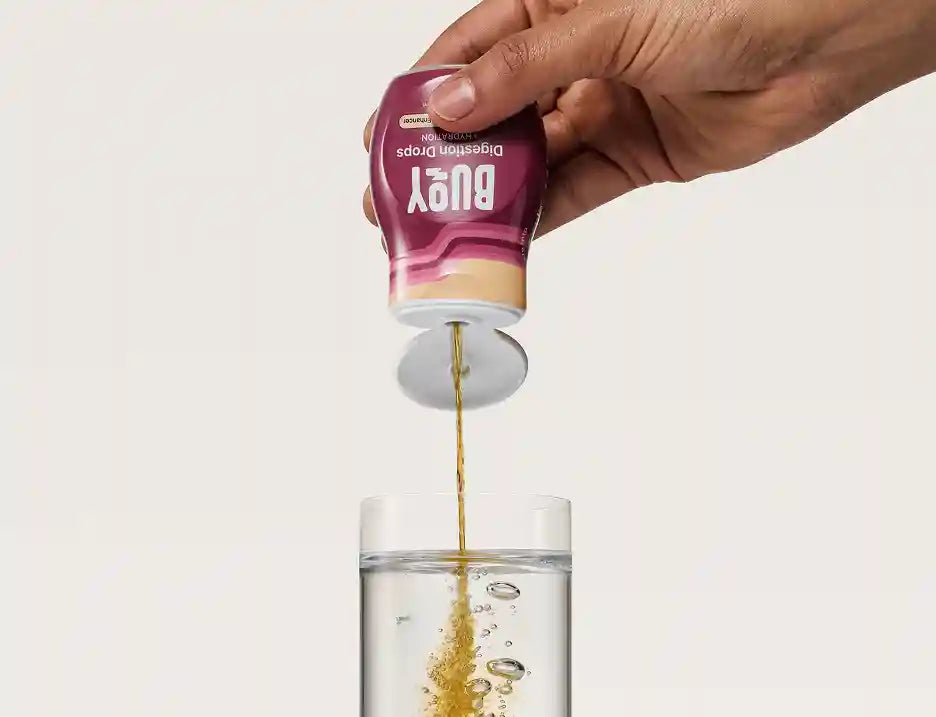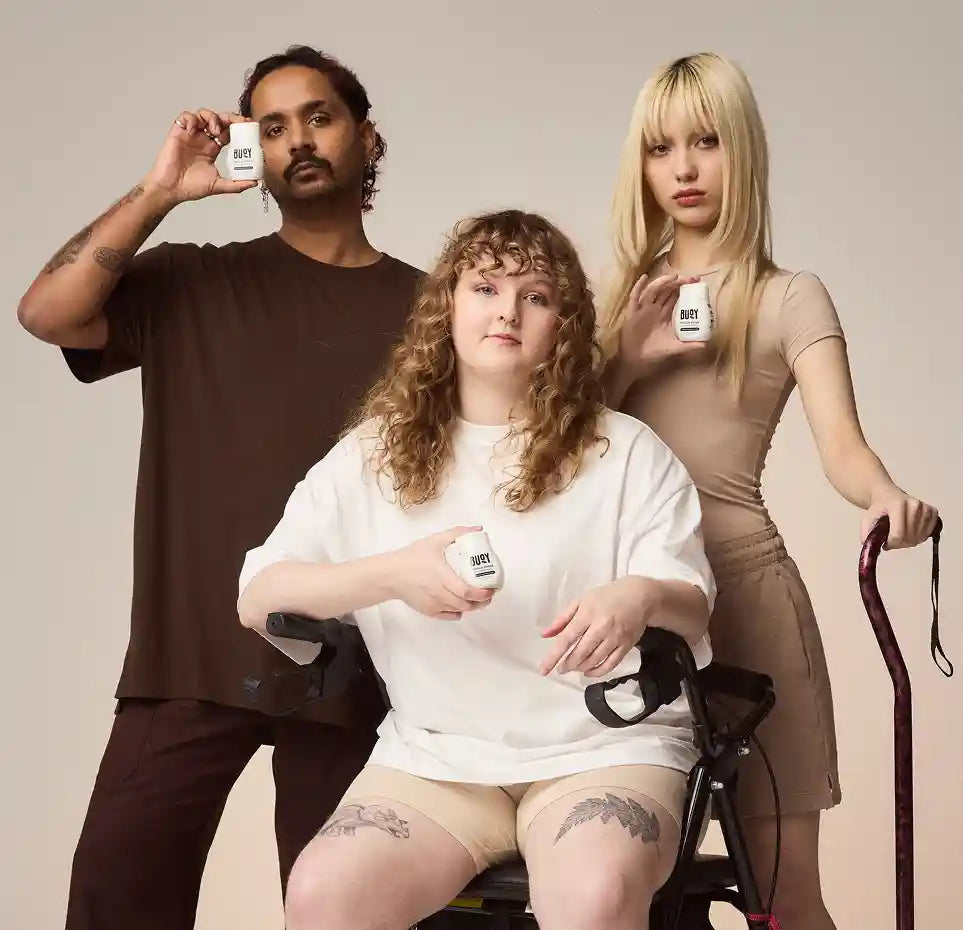
Hydration, Electrolytes, and Camping
The Link between Hydration, Electrolytes, and Camping
Camping is a great way to get out into nature and enjoy some outdoor adventure. Even a short camping trip requires some preparation, however, especially if you're planning to include other activities like hiking and climbing.
Essential Takeaways
- A camping trip is not the time to skimp on proper hydration, but lugging gallons of water to your kick-ass camping spot can make the journey pretty challenging.
- Pack a bottle of Buoy for the hydration boost you need without all the extra weight!
Check out this guide to hydration and camping to avoid getting stuck in the wilderness without adequate water and electrolytes.
- Safe Drinking Water While Camping: What You Need to Know
- The Impact of the Environment on Water Needs
- Drinking Too Much Water
- How to Stay Hydrated While Camping and Backpacking
- Recognizing Dehydration Symptoms on Camping Trips
- Finding Clean Water Sources for Camping and Hiking
- Essential Hydration Gear and Electrolyte Supplements for Campers
- Why Electrolytes Are Essential for Camping and Backpacking
- FAQs About Hydration and Electrolytes for Camping
Safe Drinking Water While Camping: What You Need to Know
The water in streams and rivers may look beautiful, but it's usually contaminated with bacteria and parasites from animal waste and activity. If you're planning a camping trip or concerned about hydration and hiking, it's important to ensure that you have access to clean, safe drinking water to avoid dehydration, especially in remote areas.
Water Sanitation
Though water treatment isn't 100% effective, it's good to know a few methods for sanitizing natural water for drinking purposes.
Waterborne illnesses are a risk for backcountry travelers, especially in countries with poor sanitation and water quality. Many of the pathogens that occur in surface water in the wilderness, even in the United States, cause diarrhea and vomiting, which can increase dehydration.
The common pathogens that occur in natural water sources include bacteria like salmonella, shigella, and E. coli; protozoa like cryptosporidium and Giardia intestinalis; and viruses like enterovirus, norovirus, rotavirus, and hepatitis A.
The following are methods for sanitizing natural water:
- Boiling is a common water treatment method that typically kills all of the above pathogens. Water should be at a rolling boil for one minute (three minutes at altitudes above 6,562 feet).
- Filtration is another water treatment method that's convenient and reliable, depending on the size of the filter, the number of contaminants, their particle size, and the charge of the particles. For some viruses, a chemical disinfectant filter is necessary. Filters designed for outdoor contaminants should have the following features: reverse osmosis, an absolute pore size of 1 micron or less, and testing and certification to NSF/ANSI Standard 53 or 58.
- A combination of filtration and chemical disinfection is the most effective water treatment method for camping.
- Salt solutions with chloride and other oxidants are effective for killing bacteria and viruses, including giardia.
Plastic bottles may be an option for camping, but it's difficult to haul enough water to maintain proper hydration on longer trips. Plastic bottles also create ecological concerns.
Before you leave home, plan how much water you need to take with you and your sanitation system so you won't be stuck out in the woods without clean water. You can look at maps before the trip to find natural water sources and figure out how much water you can bring with you and how much you can sanitize.
The Impact of the Environment on Water Needs
Water is a necessary resource for your body, and it's constantly being expelled through saliva, sweat, urination, and defecation. Water needs vary by individual, making it difficult to estimate your own water needs for an extended trip in the wild.
Water needs also depend on environmental factors, such as:
-
Climate Conditions: Hot and humid weather creates more sweat, which means you're losing more water. If you're going to be camping in hot weather, it's important to bring extra water or plan for water sources and filtration or sanitation systems to stay hydrated.
-
Exertion: If your camping trip includes a lot of hiking, climbing, or mountain biking, you're more likely to sweat and lose water and electrolytes during exercise. If you know you'll be working out during your trip, plan to drink more water and bring electrolyte supplements to avoid dehydration.
- Health conditions: Some people naturally need more water than others. For example, tall, muscular individuals need more water, as do people on certain medications or with certain medical conditions. If you're unsure about hydration during your trip, talk to your physician.
Drinking Too Much Water
Hydration is an important health concern every day, especially if you intend to be sweating in the woods. That said, it is possible to drink too much water and get a condition called hyponatremia. This occurs when you drink too much water without replacing electrolytes, namely sodium. When you drink, you lose your electrolytes, and it's important to replenish them to keep the ideal water balance. If you dilute your electrolytes, you may experience symptoms like dizziness, lethargy, fatigue, confusion, and more. To avoid this, be sure to bring an electrolyte supplement on your trip and replenish your electrolytes on a regular basis.
How to Stay Hydrated While Camping and Backpacking
Pay Attention to Thirst
Thirst is the surest sign of mild dehydration. When you're exploring the wilderness, it's easy to forget that you need to drink water. If you're exerting yourself, be sure to drink water throughout the hike or climb, especially if it's hot out or you're experiencing thirst.
If you're already thirsty, you're experiencing mild hydration. According to a study conducted by the Baylor College of Medicine, thirst is an indication of 2% dehydration. The human body can handle this level of hydration, but it can quickly turn into a more serious dehydration level that can affect physical performance, cardiovascular health, and blood pressure.
Use Sun Protection
Extreme heat and sunlight cause your body to lose valuable fluids. If you know you'll be camping or hiking in a sunny area, bring a hat and sunscreen and plan for shelter to find shade. If you're exposed to the sun excessively, you'll not only become dehydrated, but you can experience more serious conditions like sunburn, sun poisoning, heat exhaustion, and heatstroke.
Find Natural Water Sources
If you deplete the water you've brought on the trip, seek out natural water sources to replenish your water supply. We've gone over the many ways you can sterilize natural water sources to avoid illness, so you'll be prepared to sanitize lake, river, or stream water for consumption. If you have extra containers with you, be sure to fill up and sanitize so you always have a supply of freshwater.
Recognizing Dehydration Symptoms on Camping Trips
Camping creates unique challenges regarding normal hydration levels. While hiking or climbing, you'll be without a constant flow of fresh water and may need to seek natural sources for water. Under these circumstances, it's easy to drink less and become dehydrated.
Mild dehydration is nothing to be concerned about, but it can become more serious quickly. Here are some symptoms of dehydration:
- Dry skin
- Dry mouth
- Thirst
- Constipation
- Poor skin elasticity
- Dark, concentrated urine
- Decreased urination
- Headache
- Muscle
- Muscle cramps
- Dizziness or lightheadedness
- Low blood pressure
- Confusion
- Vomiting
- Fainting
Fortunately, mild to moderate dehydration is easily treated with more water and electrolyte consumption. If you are dehydrated, be sure to take an electrolyte supplement and drink water slowly, as an excess can make you vomit and lose even more water.
If the symptoms of dehydration become more severe, you need medical intervention. This is a concern with symptoms like confusion, fainting, and vomiting.
Finding Clean Water Sources for Camping and Hiking
Ideally, you'll plan out water needs and water sources prior to the camping trip. If you find yourself in need of freshwater for camping, however, here are some hydration tips to find sources:
- Ideally, you'll plan out water needs and water sources prior to the camping trip. If you find yourself in need of freshwater for camping, however, here are some hydration tips to find sources.
- Look for water at a vantage point. Higher elevations give you an excellent vantage point to spot water sources. Climb to a higher elevation and look for signs of water. If you're already significantly dehydrated, however, don't attempt the exertion.
- Search for animal activity. Both wildlife and livestock are typically found near water sources such as lakes, ponds, streams, and rivers. If you locate animals, see if you can get water from the landowner or harvest it yourself and sterilize it.
- Follow dry streams. Dry streams are identifiable by damp land on a downhill slope and smooth stones. If you locate a dry stream, follow it uphill to find its source.
- Dig for water. If you find a stream or riverbed, you can capture water that's naturally filtered by the soil. Dig straight down near the water with your hand or a rock to find filtered water, which is safer than drinking straight from the source.
- Catch rainwater. If you have a container or pot with you, put it out to catch rainfall and gain some valuable clean water. You could even catch condensation from plants with silk or another absorbent material. Moss is a natural filter as well, so you can drink rainwater and dew that collects in it or in the soil.
Essential Hydration Gear and Electrolyte Supplements for Campers
Instead of seeking out water sources when you're already camping, it's good to bring the right materials with you to prepare for expected delays or emergency situations.
When camping, be sure to pack:
Hydration Bladders
Hydration bladders are lightweight and convenient water containers that hold from 1 to 3 liters of water.
Water Filters
If you know you'll need to source water naturally, bring a good water filter or purifier. Then, set up camp near a natural water source so you won't have to worry about hydration on your trip.
Hydration Packs
Hydration packs are a system of water purifiers that consist of a reservoir in your backpack or waist with two openings: one for filling and one for a drinking tube. These hold from 1 to 3 liters of water and can be insulated against hot and cold.
Electrolyte Supplements
Electrolyte supplements ensure that you have a small, portable, and convenient hydration boost on your trip. If you're planning a camping trip, include Buoy on your supplies list! Packed with essential electrolytes, B Vitamins, and antioxidants, Buoy is lightweight, easy to store in your backpack, and gives you the fuel you need to stay happy and healthy out in the wilderness!

Why Electrolytes Are Essential for Camping and Backpacking
When you’re camping or backpacking, you’re often far from clean water sources and working harder than usual physically. This means you’re not just losing fluids through sweat - you’re also losing essential electrolytes like sodium, potassium, and magnesium. Without replacing them, you risk dehydration, muscle cramps, fatigue, and even hyponatremia (low sodium).
Electrolytes help your body absorb and retain water more efficiently, regulate your body temperature, and keep your energy levels steady. Portable electrolyte drops like Buoy’s are perfect for outdoor adventures—they’re lightweight, sugar-free, and easy to add to any water source, helping you stay hydrated and healthy on the trail.
FAQs About Hydration and Electrolytes for Camping
1. How do I stay hydrated while camping?
To stay hydrated while camping, drink water regularly throughout the day, even if you’re not thirsty. Bring a hydration pack or water bottles, and plan access to clean water using filters or purification tablets. Add electrolyte drops like Buoy to help your body absorb and retain fluids efficiently, especially if you’re active or in hot weather.
2. Why are electrolytes important for camping trips?
Electrolytes are vital for camping because they help regulate hydration, muscle function, and energy levels. When you sweat during hikes or outdoor activities, you lose sodium, potassium, and magnesium. Without replenishment, you risk dehydration, cramps, and fatigue. Adding electrolytes to your water ensures your body can stay hydrated and perform well.
3. What are the best hydration tips for backpacking?
For backpacking, pack lightweight hydration tools like collapsible bottles or a hydration bladder. Drink small amounts frequently and replenish electrolytes using drops or tablets. Avoid overhydrating with plain water to prevent hyponatremia. Plan your route around natural water sources and carry a portable water filter for emergencies.
4. Can electrolyte drops help with dehydration on hikes?
Yes, electrolyte drops can help prevent and address dehydration while hiking. They replace lost minerals from sweat and support fluid retention, which plain water can’t do alone. Buoy’s drops are especially convenient—they’re compact, sugar-free, and easy to add to any drink, making them ideal for outdoor use.
5. How much water should I drink per day when camping?
Your water needs depend on climate, activity level, and personal factors, but a good rule is 2-4 liters per day for moderate activity. In hot weather or with intense hikes, you may need more. Pair water with electrolytes to maintain proper hydration and avoid overhydrating with plain water.
6. What are signs of dehydration while camping?
Signs of dehydration while camping include dry mouth, dark urine, fatigue, dizziness, and muscle cramps. Severe dehydration can lead to confusion or fainting. To prevent this, drink water regularly and supplement with electrolytes. Pay attention to thirst—it’s already a signal of mild dehydration.
7. Are electrolyte supplements worth bringing on camping trips?
Absolutely. Electrolyte supplements are compact, lightweight, and help keep your body hydrated more effectively than water alone. They’re especially useful in hot climates or during strenuous activities. Buoy’s electrolyte drops fit easily in your pack and can be added to any water source for a hydration boost.
References:
- Thirsty? You're already dehydrated. Baylor College of Medicine. https://www.bcm.edu/news/thirsty-you-are-already-dehydrated
- Centers for Disease Control and Prevention. (2015, April 3). A Guide to Water Filters. Centers for Disease Control and Prevention. https://www.cdc.gov/parasites/crypto/gen_info/filters.html.
- https://campingcooks.com/hydration-basics-for-camping/
- https://www.rei.com/learn/expert-advice/hydrate.html
- https://www.doityourselfrv.com/staying-hydrated/
- https://blog.nols.edu/2015/06/26/6301
- https://www.campingoracle.com/tips-to-stay-hydrated-in-hot-weather-while-camping-and-hiking-outdoors/




